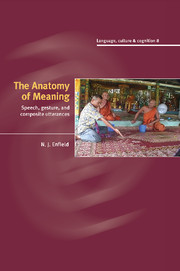7 - Editing
Published online by Cambridge University Press: 21 July 2009
Summary
A wave is not an individual except for the man who regards it and sees it advancing toward him.
Maurice Merleau-Ponty, 1942This chapter zeroes in further on the elaborate enchronic structure of composite utterances in sequence, tracking the consequences of their uncanny persistence and coherence. We here highlight their extraordinary robustness and flexibility. We shall consider two examples in detail, from informal interviews about kinship and kin terminology, discussed already in Chapter 6. The diagrams not only display spatial integrity and temporal persistence but also may be adjusted, revised, or edited online, as the need arises. There are at least three reasons why speakers who create gesture diagrams or models may find themselves in need of making some revision. First, they may make errors in representation (e.g. I may have forgotten some component or I may have the proportions wrong and find myself now unable to fit some part of the structure in). Second, they may reach the physical limitations of gesture space, placing some part of their diagram at the extreme of arm's reach, only to find that the next part of their developing diagram needs to be placed even farther out (or, indeed, finding that some part of the diagram needs to be placed closer to their body than they have allowed space for). Third, the semiotic motivation for the structural configuration of the diagram may change as the diagram develops.
- Type
- Chapter
- Information
- The Anatomy of MeaningSpeech, Gesture, and Composite Utterances, pp. 194 - 220Publisher: Cambridge University PressPrint publication year: 2009

